Equinamity-A Revolution in Horse and Rider Training
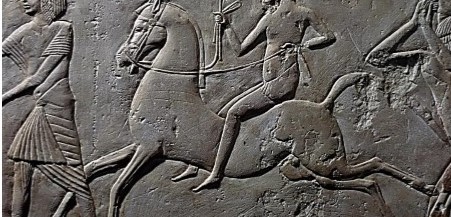
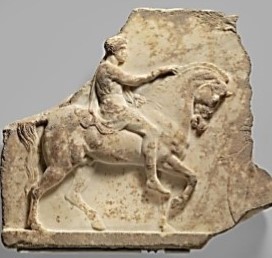

Source: www.ancientart.as.ua.edu


The above images make it crystal clear that rolklur was one of the methods used to train horses over two thousand years ago.
There are two ways to achieve it: one is by an exaggerated hand pressure on the reins and the second is via a curb bit.
It needs to be remembered that rollkur is all about the head and neck angle. The previous post referred to the angle of the horse’s head vs the ground. This compares what is normal vs what is forced.
The aspect of what is natural and what is forced is a complex one. This subject will be reviewed in a range of posts which follow. The posts are based on extensive academic studies of the horse’s bodily dynamics.
However, the method of forcing the horse’s head and neck to adapt to human needs is not new. Its history goes back several thousand years.
Let’s start with the following quotation:
“The early horsemen of Central Asia and Eastern Europe used methods of control that were not made of metal; instead they were leather thongs, bone or wood. They were tied to cheek pieces made of antler. This early evidence for the use of bits comes from an archaeological site in Dereivka, Ukraine. Archaeologists have also found 5,000 year old equine remains with evidence of bit wear on the second pre molar teeth.
The earliest records of metal bits date from roughly the 14th century BC and were originally made of bronze. These discoveries were made in the region of Luristan, in ancient Mesopotamia; present day Iran. Plain and jointed mouthpieces appeared at the same time, often with highly ornamented cheekpieces.
The first records of the curb bit are from around the 4th Century BC. Much later, the mediaeval warhorse was often ridden in a curb bit with an extremely high port and long shanks. Their purpose was to increase the leverage on the curb and the pressure on the horse’s poll; some bits also put pressure on the nose”.
There is a dramatic break in the method of controlling horses which arrived with the invention of the curb bit. Before that the horses had head and neck positions which is similar to that shown next.

However, the invention of the curb bit changed many things including battlefield tactics. New movements became part of the cavalry’s repertoire.
The riders and warriors of antiquity were now able to get their horses to perform leaps and twists off the ground for military advantage. With this style of bit the riders were able to get the horses to be light in the hand and to be guided with one hand. Or even by the rider’s teeth as the next image shows.
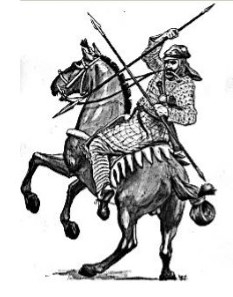
This image shows the rider controlling the horse with only the reins. If they are held in the rider’s mouth it meant that the horse had to be both collected and responsive.
However, the curb bit also meant that the horse’s head could be pulled into its chest. Examples are shown in the next sculpture.
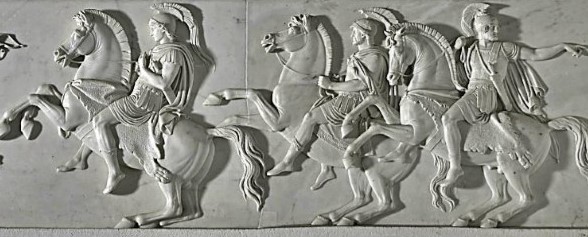
And is it the best (or only way) to obtain collection?
As has been mentioned, hard hands, severe bits and artificial aids are all ways that a rider or trainer can use to place the horse’s head in the desired position.
As can be seen in the above image, the use of side reins for this purpose started over two thousand years ago. Some collection of the horse was obtained by the use of short reins, with straight metal bars or snaffle type bits.
An Iron Age bit is shown next. This period lasted roughly from 1,200 to 600 BCE.
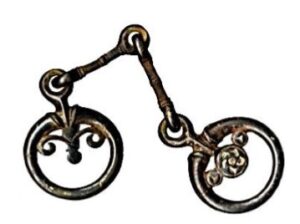
Extensive mouth control was essential on the battlefield. Consequently, riders and trainers accepted the new development of very severe bits to obtain maximum submission. The bits had three key features: long shanks, curb chains, and ports. Often the bridle also included an element to apply pressure on the nose.
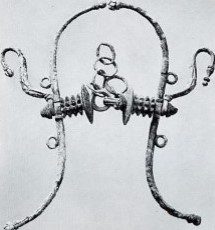
However, it is important to note that Xenophon was also an advocate for the use of two bits, one more severe than the other. He indicated that a less severe bit could be used. The following quote is taken from Xenophon “On the Art of Horsemanship”, Chapter 10, which was written about 355 BCE:
“To begin with, you should possess two bits at least. One of these should be smooth and have the discs of a good size; the other should have the discs heavy and low, and the teeth sharp, so that when the horse seizes it he may drop it because he objects to its roughness, and when he is bitted with the smooth one instead, may welcome its smoothness and may do on the smooth bit what he has been trained to do with the aid of the rough one”
The less severe bit is shown next.

Xenophon states on the subject of bits that: “The rider may control the severity of the bit by controlling the amount of slack in the rein. Then, when he is ridden in the milder bit, he will be grateful for its smoothness, and will perform all his movements with greater happiness and exuberance. The large discs on the smooth bit will prevent him from taking hold”..
This advice was of great value at the time of writing. But it is not the sort of counsel that current riders need or expect for training their dressage horses.
The curb chain has several functions. It is: to get collection, to help with steering, and to transfer some of the horse’s weight from the front to its haunches. This third function was needed for the so-called “airs off the ground” which were essential for certain battlefield manoeuvers.
However, it remains indisputable that the curb bit can cause extreme effects, as shown next.
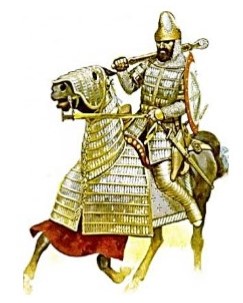
These images show that the cavalry role for horses and riders was one of aggression and violent movements. And all training and tack was designed to maximize their effectiveness.
The current change to recreational riding means that many of their original functions and methods for training are no longer applicable.